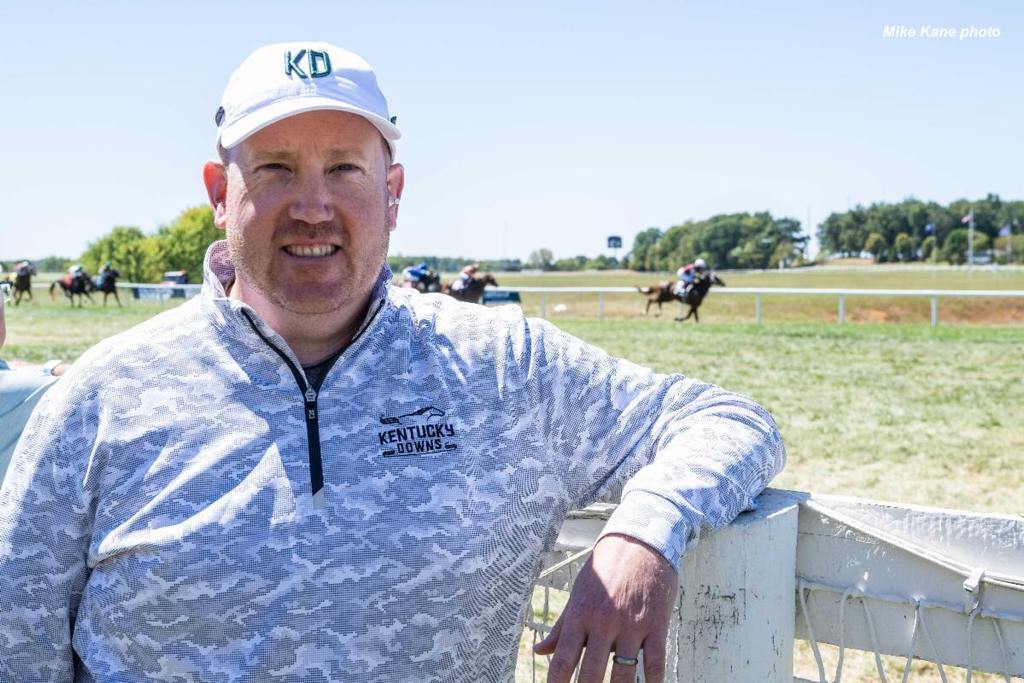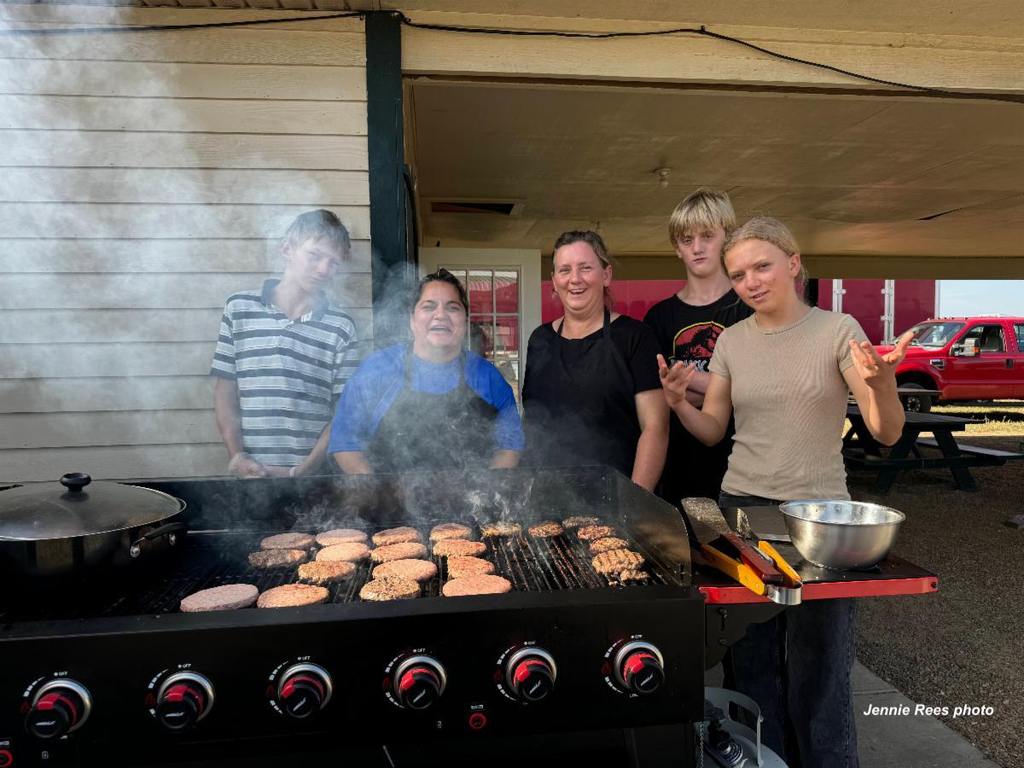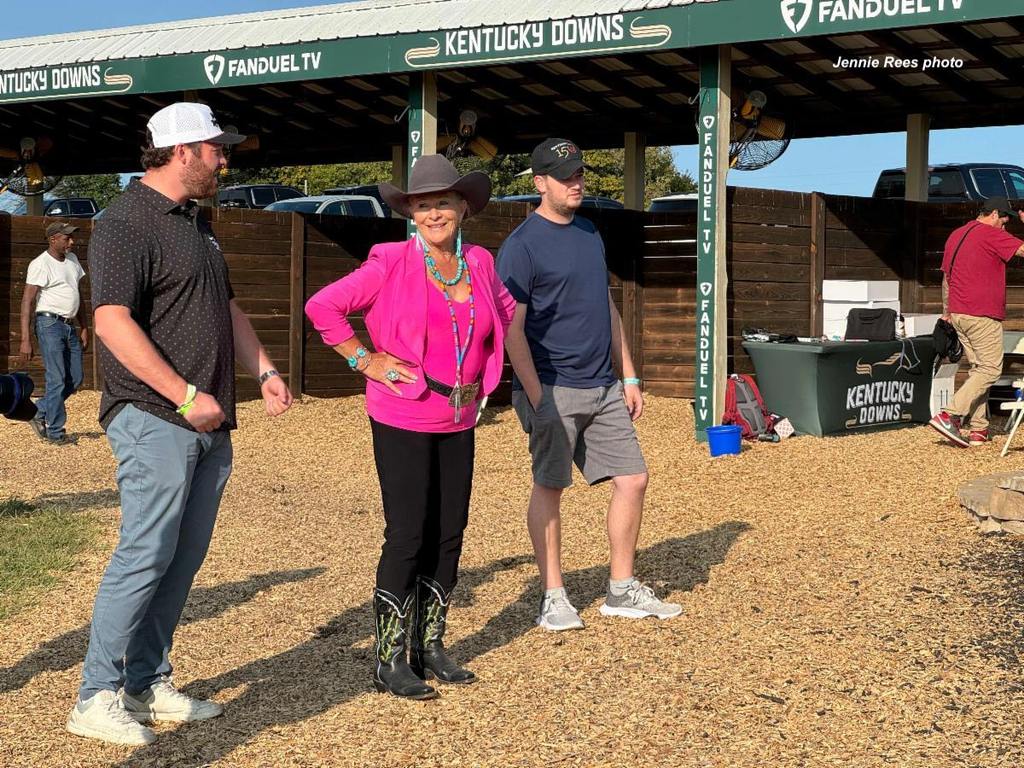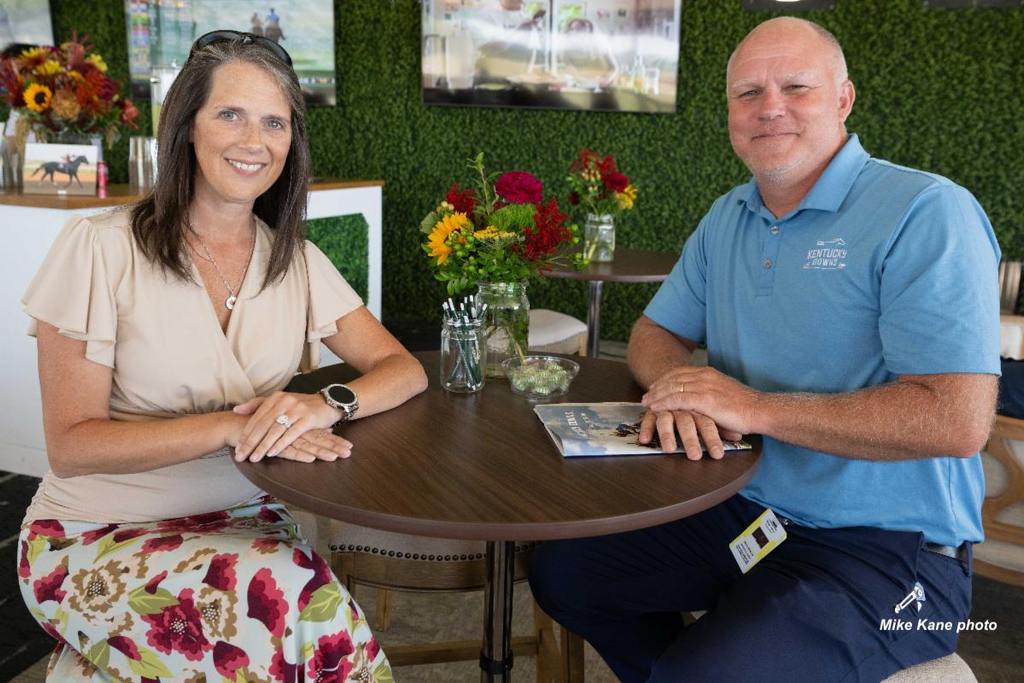
Gold Rabbit Sports vice president Matt Murphy. The winning horse shown in front in the background is Black Iron, owned by Kentucky Downs’ co-managing partner Ron Winchell and Doug Branham. (Mike Kane photo)
“When you run a racetrack, it doesn’t matter if it’s seven days or 107 days, you still have to prepare, and this crew does a great job.”
Story by Jennie Rees
FRANKLIN, Ky.—Kentucky Downs’ seven-day race meet will barely be concluded before the preparation for 2025 will begin.
Almost immediately after Wednesday’s closing card, operations consultant Matt Murphy will task Kentucky Downs employees, vendors, contractors and consultants to do a deep dive into what went right, what went wrong and how all facets can be made better.
Murphy, who lives in Norwalk, CT, is vice president of Gold Rabbit Sports, which plans and oversees operations and logistics in all areas for sporting and other events. With the exception of racing and wagering, if it’s a detail involving the Kentucky Downs race meet, Murphy is involved. That includes the ticketing process, reserved seating areas, general admission areas, hotel reservations, off-site parties, contracting vendors, catering, temporary staffing, signage and much more.
“It is organized chaos,” Murphy said at Kentucky Downs in a rare instance of sitting down. “It is probably 75% percent overlay, meaning it doesn’t live here 52 weeks a year. The gear gets setup, utilized, and returned to a vendor or storage over a three-week period. It’s getting less and less overlay with the ownership’s willingness to invest in permanent structures and operations materials.”
If Murphy is the master planner, Erik Kornmeyer of Bowie, Md., is the right arm that gets things done. Need another table in the officials/media tower? Call Erik. An owner landed at the Nashville/Bowling Green/Portland, Tenn., airport, Erik’s on the way. Water and ice in the paddock for horses and humans, along the outer track rail, basically everywhere? Erik’s on it. There’s no telling what the man might be hauling in his golf cart or Gator.
Kentucky Downs co-managing partner Ron Winchell met Kornmeyer four years ago at the Preakness Stakes in Baltimore when Kornmeyer was assigned to be the prominent horse owner’s driver. Winchell saw an engaging personality and valuable skill set in the soon-to-be retired firefighter in Anne Arundel County (think Annapolis), Md., including serving as public information officer. Erik worked his first Kentucky Downs meet later that year, doing whatever needs to be done. Which just keeps growing.
“The Mint has an excellent facilities team,” Kornmeyer said. “But they run a pretty large facility. So, the operation team that comes in from out of state provides additional resources. We hire some local people as well. Matt and I coordinate that team and make sure all the needs are met for our media, our horsemen, our catering team, our bartending team. We make sure our caterers, bar staff, hostess staff have what they need.”
Ted Nicholson, Vice President of Racing for Kentucky Downs and ECL Entertainment’s other racing properties, calls it “a great team we keep on building every year,” drawing on talent from across the country.
“It’s not one person, it’s the whole group,” he said. “We bring in guys like Matt and Erik who are true pros. I don’t think people realize what goes on behind the scenes. When you run a racetrack, it doesn’t matter if it’s seven days or 107 days. You still have to prepare, and this crew does a great job.”
Among the many things Kornmeyer brought to the table was his wife, Stacy, who recently retired as a schoolteacher, a position that included overseeing logistics for the school during Covid. At Kentucky Downs, she oversees the wide territory that is hospitality.
In a couple of months, Stacy Kornmeyer will start planning table layouts and picking out décor for the reserved dining areas so that no two days will look the same at the 2025 meet. Her job entails “helping to coordinate all the operations and special things and special touches”.
“I have a lot of numbers on speed dial, like housekeeping,” she said. “… My feet touch every area during racing days. I’m from the paddock all the way to the Stretch Run tent, trying to anticipate the needs of everybody. But I also get to be a ‘day maker.’ We had a gentleman who was 88 years old. It was his birthday. He’d never been to a racetrack to see live racing. He’s from Franklin and decided to come and stay in the hotel and do racing.”
She upgraded the gentleman from the Stretch Run to the VIP Chalet, where mutuel clerks sang Happy Birthday to him every time he placed a bet.

With Winchell and co-managing partner Marc Falcone’s Las Vegas-based ECL Entertainment purchasing Wyoming Downs this year with Clairvest Group, Kentucky Downs tapped into that track’s talent. That includes bringing in Andrea LeBaron Stowell, her long-time friend Martha Trigueros and LeBaron Stowell’s three teenage kids to operate the backstretch kitchen. Kentucky Downs’ horsemen’s group, the Kentucky Horsemen’s Benevolent & Protective Association, is picking up the cost of feeding backstretch workers and others for free throughout the meet from 6 a.m. to 1 p.m.
“The other day we probably did 140 breakfast burritos, about 80 burgers and probably another 30-40 chicken burgers — and probably 50 hotdogs on top of that,” LeBaron Stowell said.

Judy Horton’s many hats at Wyoming Downs include overseeing publicity, sponsorships, events and being the track’s lobbyist. At Kentucky Downs, there’s a trophy presentation for every race. Horton makes sure the winner’s circle presentations run smoothly and that the winners get ushered to the Trophy Bar outside the paddock to celebrate.
“My team is very lean,” Murphy said. “We rely a lot on The Mint staff to do a lot of the stuff, where they have day (and night) jobs and do a great job with it. There’s no such thing as a down season for them. There’s a passion for building this that everyone shares.”
Murphy said he works with The Mint’s Human Resources Director Jeana Harper to fill scores of temporary positions.
“We serve lunches to about 420 people who work outside, and 200 more working inside The Mint on a given day,” Murphy said. “That’s over 400 people who have the slice of the pie when it comes to operating this. … It’s a year-round project for a few of us. It’s about a six-month project for a few dozen people. And then it’s a two- or three-week project for a few hundred people.”





